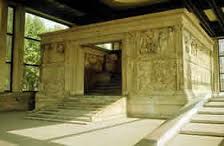The Ara Pacis Augustae (Latin, “Altar of Augustan Peace”; commonly shortened to Ara Pacis) is an altar to Peace, the Roman goddess. The monument was commissioned by the Roman Senate on 4 July 13 B.C. to honour the return of Augustus to Rome after his military campaigns, and consecrated on 30 January 9 BC by the Senate in celebration of the peace brought to the Roman Empire by Augustus military victories. The Altar was originally located on the northern outskirts of Rome, a Roman mile from the boundary of the pomerium on the west side of the Via Flaminia. It stood in the northeastern corner of the Campus Martius and on the flood plain of the river Tiber, where it became buried under four metres of silt over the centuries. The Ara Pacis was substantively rediscovered in the twentieth century, and moved to its current location in 1937–1938. The altar was meant to be a vision of the Roman civil religion. It is made up of a small functional altar at its centre, and four surrounding walls; externally, two-tier friezes run along the walls and portray the peace and fertile prosperity enjoyed as a result of the peace brought to Rome by Augustus’ military supremacy. The Altar was built to remind Romans, through a visual medium, of the competence and achievements of the Julio-Claudian dynasty. The sculpture on the outside of the monument emphasise the importance of piety (pietas) and peace within the empire.
Monthly Archives: April 2013
Presentazione del progetto
2013-04-15-12-53-52.jpg

team4 a lavoro!!
ara pacis Roma

questa è l’ ara pacis, un’ opera che abbiamo avuto modo di studiare da vicino quest’anno tramite la gita a Roma
video di presentazione
video di presentazione
Paste a Video URL
Presentazione del team4
Ciao a tutti siamo il team4 della 1E dell’istituto Giustino Fortunato di Rionero in Vulture. Siamo molto interessati a questo progetto e pensiamo di fare un buon lavoro. Per questo progetto vogliamo parlare della legalità e della costituzione espressa nell’opera d’arte dell’Arapacis opera che avremo modo di studiare da vicino quest’anno nel viaggio d’istruzione a Roma.
Gli alunni:
-Croce Nicla
-Gagliotti Giulio
-Giordano Francesco
-Liguori Imma